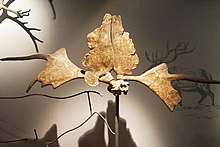Sinomegaceros
Sinomegaceros is an extinct genus of deer known from the Early to Late Pleistocene of East Asia. It is considered to be part of the group of "giant deer" (often referred to collectively as members of the tribe Megacerini), with a probable close relationship to Megaloceros. Many members of the genus are noted for their distinctive palmate antler brow tines.
| Sinomegaceros | |
|---|---|
| Sinomegaceros yabei at the National Museum of Nature and Science, Tokyo | |
 | |
| Sinomegaceros pachyosteus | |
| Scientific classification | |
| Kingdom: | Animalia |
| Phylum: | Chordata |
| Class: | Mammalia |
| Order: | Artiodactyla |
| Family: | Cervidae |
| Subfamily: | Cervinae |
| Genus: | †Sinomegaceros Dietrich, 1933 |
| Species | |
| |
Taxonomy

The first species of the genus S. ordosianus and S. pachyosteus were named by legendary Chinese paleontologist C. C. Young as species of Cervus in 1932 for material from Zhoukoudian.[1] In a review of the paper the subsequent year Dietrich created the name Sinomegaceros as a subgenus of Cervus to house the species, with S. pachyosteus as the type.[2] Due to the fact that the name was not published in a formal research paper it was not widely used for several decades after publication. The species S. yabei was named in 1938.[3] In the following decades various researchers considered it a subgenus of Megaloceros,[4][5] or a distinct genus.[6][7] Several named species are likely to be junior synonyms.[8] The best known species are Sinomegaceros yabei from the Middle to Late Pleistocene of Japan, alongside Sinomegaceros pachyosteus from the late Early Pleistocene to Late Pleistocene of China. An unpublished PhD thesis of mitochondrial genomes from Sinomegaceros found that they were part of Cervinae, and were within the clade containing mitochondrial genomes of the Irish elk, suggesting introgression.[9]
Evolution
The oldest known species in China is S. konwanlinensis from the lower Lishui Formation, around 1.1-1.15 Ma. S. pachyosteus appears around 1 Ma. Among the youngest known dates of S. ordosianus are around 35-50 kya in the Ordos. S. yabei first appears in the latter half of the Middle Pleistocene in Japan.[10] It has been suggested that both S. pachyosteus and S. yabei ultimately derive from S. konwanlinensis.[8] The latest reliable dates for S. yabei are around 40 kyr BP.[11]
References
- Young, C.C., 1932. On the Artiodactyla from the Sinanthropus site at Chouk’outien. Palaeontogia Sinica, Series C 8 (2), 159
- Dietrich, W.O., 1933. [Review of] C.C. Young: on the Artiodactyla from the Sinanthropus Site at Choukoutien. Neuest Jahrbuch fu ̈r Miner-alogie, Geologie und Pala ̈ontologie. Referate, III 1933(2), 475–477.
- Shikama, T., 1938. Discovery of giant fallow deer from the Pleistocene in Japan. Japanese Journal of Geology and Geography 16 (1–2), 115–122
- Kahlke, H.D., Hu, C.-k., 1957. On the distribution of Megaceros in China. Vertebrata PalAsiatica 1 (4), 273–283 pl. 1.
- Kahlke, R.D., 1999. The history of the origin, evolution and dispersal of the Late Pleistocene Mammuthus-Coelodonta faunal complex in Eurasia (large mammals). Mammoth site of Hot Springs, SD, inc., 219.
- Shikama, T., Tsugawa, S., 1962. Megacerid remains from Gunma Prefecture, Japan. Bulletin of the National Science Museum 6 (1), 1–13.
- Otsuka, H., Shikama, T., 1977. Studies on fossil deer of the Takao Collection (Pleistocene deer fauna in the Seto Inland Sea, West Japan— Part 1). Bulletin of the National Science Museum 3 (1), 9–40 pls. 1-6.
- van der Made, J.; Tong, H.W. (March 2008). "Phylogeny of the giant deer with palmate brow tines Megaloceros from west and Sinomegaceros from east Eurasia". Quaternary International. 179 (1): 135–162. Bibcode:2008QuInt.179..135V. doi:10.1016/j.quaint.2007.08.017.
- Rey de la Iglesia, Alba (2018). Ancient DNA and novel molecular methods in modern population genomics: Evolutionary history of Eurasian deer species (PhD thesis). University of Copenhagen.
- Vislobokova, I. A. (December 2012). "Giant deer: Origin, evolution, role in the biosphere". Paleontological Journal. 46 (7): 643–775. doi:10.1134/S0031030112070027. ISSN 0031-0301.
- Iwase, Akira; Hashizume, Jun; Izuho, Masami; Takahashi, Keiichi; Sato, Hiroyuki (March 2012). "Timing of megafaunal extinction in the late Late Pleistocene on the Japanese Archipelago". Quaternary International. 255: 114–124. Bibcode:2012QuInt.255..114I. doi:10.1016/j.quaint.2011.03.029.